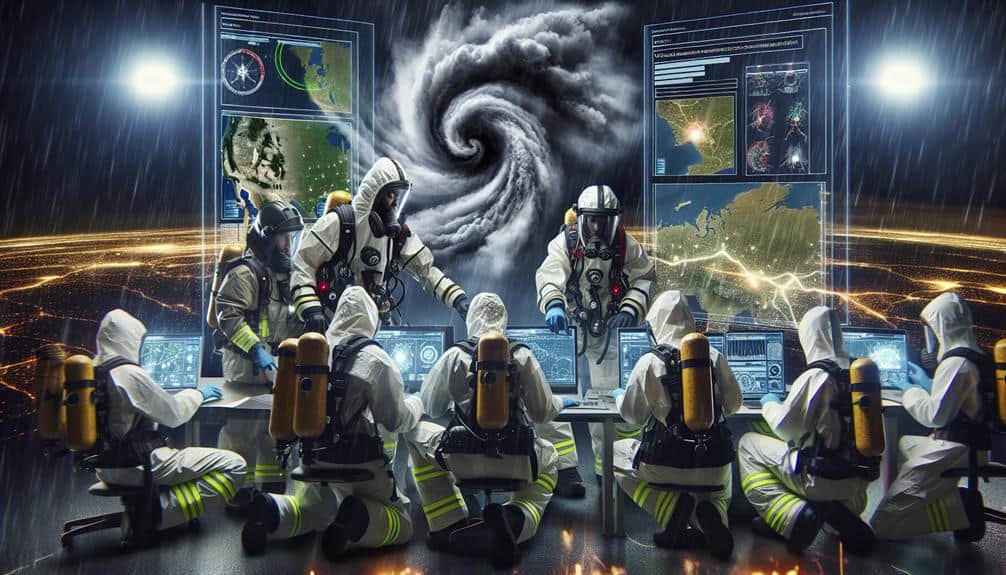We must prioritize safety when intercepting severe thunderstorms due to their extreme and unpredictable nature. Radar imagery and satellite observations offer real-time data on storm structures, while atmospheric soundings provide critical vertical profiles. Proper gear like high-visibility jackets, helmets, and weather radios are essential. Regular vehicle maintenance and emergency kits enhance our resilience. Reliable communication systems and well-defined protocols guarantee prompt and informed decisions. Continuous monitoring and predefined evacuation routes minimize risks. Without rigorous safety measures, the volatile conditions can escalate, compromising our operations. Stay tuned to learn how each element integrates for thorough storm interception.
Key Points
- Protective gear prevents injuries from hail, debris, and other hazards during severe storms.
- Real-time weather updates are essential for making informed decisions and avoiding danger.
- Predefined evacuation routes ensure swift and safe withdrawal from high-risk areas.
- Emergency kits and vehicle preparation enhance resilience and safety during severe weather conditions.
Understanding Meteorological Data
To effectively intercept severe thunderstorms, we must first analyze meteorological data, including radar imagery, satellite observations, and atmospheric soundings, to predict storm behavior accurately. This data, essential for storm tracking, allows us to identify weather patterns that indicate the potential for severe weather events.
By examining radar imagery, we can track the development and movement of storm cells in real time, noting features such as hook echoes and velocity couplets that signify rotation within the storm. Satellite observations provide a broader view, helping us identify mesoscale convective systems and the overall structure of storm complexes. These images reveal cloud tops, temperature profiles, and moisture content, offering clues about storm intensity and potential for severe weather.
Atmospheric soundings, obtained from weather balloons, give us vertical profiles of temperature, humidity, and wind speed. This data helps us understand the instability and shear within the atmosphere, key factors in storm development. By integrating these data sources, we can build a detailed picture of the current weather patterns, enabling us to make informed decisions on when and where to intercept storms safely.
Analyzing meteorological data empowers us to anticipate storm behavior, ensuring our pursuit of freedom in storm tracking is grounded in scientific precision.
Essential Safety Gear
Equipping ourselves with necessary safety gear is vital for guaranteeing our protection and effectiveness while intercepting severe thunderstorms. Protective clothing, such as high-visibility jackets, waterproof outer layers, and steel-toed boots, is non-negotiable. These items guard against flying debris, torrential rain, and potential electrical hazards from lightning strikes. High-visibility gear guarantees we remain visible to other storm chasers and emergency responders, reducing the risk of accidental injuries.
Safety equipment goes beyond clothing. Helmets with face shields protect our heads and eyes from hail and high-speed debris. A reliable weather radio is essential for real-time updates on storm movements and warnings. Additionally, handheld anemometers measure wind speeds, providing data to make informed decisions about our positioning and movements.
First aid kits should be inclusive, including items like antiseptics, bandages, and emergency thermal blankets. Fire extinguishers are also important, as electrical fires can start easily during severe weather events.
Being prepared with this gear not only enhances our safety but also empowers us to face the storm with confidence and agility. By prioritizing our protection, we guarantee that we can continue to chase these powerful natural phenomena without compromising our well-being.
Vehicle Preparation Tips
Preparing our vehicle thoroughly guarantees it withstands the harsh conditions encountered during severe thunderstorms. Let's focus on optimizing our readiness through meticulous vehicle preparation.
First, maintaining a robust emergency kit is crucial. Our kit should include essentials like first aid supplies, non-perishable food, water, flashlights, batteries, and thermal blankets. Detailed analysis reveals that having a well-stocked emergency kit enhances our self-sufficiency and resilience during unexpected events.
Second, ensuring our vehicle is mechanically sound is essential. Regularly checking tire pressure, brake functionality, and fluid levels can prevent breakdowns during critical moments. Data-driven insights suggest that properly maintained vehicles are less likely to encounter failures under severe weather stress.
Third, integrating real-time weather updates into our navigation system allows us to make informed decisions. Subscribing to reliable weather alert services and using apps that provide up-to-the-minute forecasts can guide us away from the storm's most dangerous zones. Technical advancements in meteorological predictions have made it easier to stay ahead of severe weather patterns.
By adhering to these preparation strategies, we equip ourselves with the freedom to navigate severe thunderstorms with increased safety and confidence.
- Emergency kit
- Mechanical check
- Weather updates
Communication Best Practices
Effective communication during severe thunderstorms is pivotal, as it guarantees timely coordination and enhances our ability to respond to rapidly changing conditions. When intercepting severe weather, our primary focus should be on real-time weather updates. By utilizing advanced meteorological tools, we can monitor storm movements, wind speeds, and precipitation rates. This data empowers us to make informed decisions quickly.
Team coordination becomes critically important under these circumstances. We need to establish a robust communication network, leveraging radios, mobile devices, and satellite communications to maintain constant contact. Each team member should have a clearly defined role and be aware of the specific communication protocols. For instance, designated weather spotters should relay information about storm developments to the central command, while drivers focus on safe navigation.
Moreover, we should implement redundancy in our communication systems to safeguard we're not relying on a single point of failure. Backup power supplies and alternative communication channels can mitigate risks associated with technical malfunctions. By meticulously planning our communication strategies, we enhance our operational efficiency and protect our freedom to navigate safely through severe thunderstorms.
Effective communication isn't just a best practice; it's a lifeline.
Emergency Procedures

When severe thunderstorms escalate, our emergency procedures must be carefully carried out to guarantee the safety of all team members. Following a structured emergency response confirms that we minimize risks and maintain operational efficiency. Adhering to safety precautions is non-negotiable when dealing with volatile weather conditions.
Our emergency response plan includes several critical steps:
- Immediate Assessment: We continuously monitor meteorological data to evaluate the storm's intensity and trajectory. This data-driven approach allows us to make informed decisions and adapt our tactics in real-time.
- Evacuation Protocols: If the storm's severity necessitates evacuation, we execute predefined evacuation routes to assure swift and safe withdrawal from danger zones. Every team member must know these routes and the specific conditions that trigger an evacuation.
- Communication Systems: Robust communication channels are essential. We use encrypted radios and satellite phones to maintain contact, ensuring that everyone is informed of the evolving situation and any necessary adjustments to our emergency response.
Frequently Asked Questions
What Are the Psychological Impacts of Chasing Severe Thunderstorms?
Chasing severe thunderstorms can greatly impact our mental health, leading to stress and anxiety. The emotional toll includes heightened adrenaline, potential trauma, and long-term psychological effects, backed by data indicating increased risk for anxiety disorders among storm chasers.
How Can Pursuing Thunderstorms Affect Local Wildlife?
When we pursue thunderstorms, we stir the pot of ecosystems, impacting local wildlife. Our presence can disrupt habitats and stress animals. Prioritizing wildlife conservation and analyzing data guarantees we balance our quest for freedom with nature's needs.
What Are the Legal Implications of Storm Chasing?
When chasing storms, we've got to weigh liability risks and insurance requirements. Legal implications can include fines or lawsuits if our actions cause damage or harm. Ensuring proper insurance coverage mitigates potential financial consequences and regulatory penalties.
How Do Severe Thunderstorms Influence Local Economies?
We observe that severe thunderstorms have a substantial impact on local economies through direct damages and disruptions. However, analyzing data shows community resilience initiatives can mitigate these economic impacts, ensuring faster recovery and sustained economic activities.
What Are the Ethical Considerations in Sharing Storm Footage?
Ironically, while thrilling storm footage captivates audiences, we must guarantee informed consent and address privacy concerns. Detailed analysis of data reveals that ethical sharing respects individual rights, balancing public interest with personal freedom.


